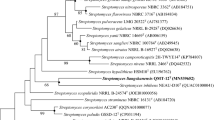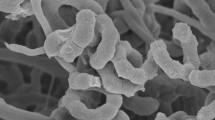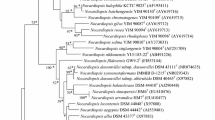Abstract
An alkaliphilic actinobacterium, designated EGI 80050T, was isolated from a desert soil sample of Xinjiang, north-west China, and characterized by a polyphasic approach. The isolate was observed to produce purple orange-yellow aerial mycelium and dark orange-yellow substrate mycelium on yeast extract-malt extract agar medium. Whole-cell hydrolysates of strain EGI 80050T were found to contain ll-diaminopimelic acid as the diagnostic diamino acid, and galactose, glucose, rhamnose and mannose as the main sugars. The major fatty acids identified were C16:0-iso (36.8 %), C15:0-anteiso (17.3 %), 15:0-iso (13.2 %) and 14:0-iso (10.5 %). The predominant menaquinones detected were MK-9(H6) and MK-9(H8), while the characteristic polar lipids were identified as diphosphatidylglycerol, phosphatidylglycerol, phosphatidylinositol, phosphatidylinositol mannosides, phosphatidylmethylethanolamine and three unknown phospholipids. The G+C content of the genomic DNA was determined to be 67.9 mol%. Phylogenetic analysis based on 16S rRNA gene sequences affiliated the strain EGI 80050T to the genus Streptomyces. Levels of 16 rRNA gene sequence similarities between strain EGI 80050T and Streptomyces candidus NRRL ISP-5141T, Streptomyces cremeus NBRC 12760T, Streptomyces spiroverticillatus NBRC 12821T, Streptomyces violaceorectus NBRC 13102T, Streptomyces cinereoruber subsp. cinereoruber NBRC 12756T were 96.7, 96.6, 96.6, 96.6 and 96.6 %, respectively. Based on the phenotypic, chemotaxonomic and phylogenetic data, strain EGI 80050T is considered to represent a novel species of the genus Streptomyces, for which the name Streptomyces fukangensis sp. nov. (type strain EGI 80050T = BCRC 16945T = JCM 19127T) is proposed.


Similar content being viewed by others
References
Bérdy J (2005) Bioactive microbial metabolites: a personal view. J Antibiot 58:1–26
Bérdy J (2012) Thoughts and facts about antibiotics: where we are now and where we are heading. J Antibiot 65:385–395
Collins MD, Pirouz T, Goodfellow M, Minnikin DE (1977) Distribution of menaquinones in actinomycetes and corynebacteria. J Gen Microbiol 100:221–230
Euzéby JP (2012) List of prokaryotic names with standing innomenclature: a folder available on the internet. http://www.bacterio.cict.fr/s/streptomycesa.html
Felsenstein J (1981) Evolutionary trees from DNA sequences: a maximum likelihood approach. J Mol Evol 17:368–376
Felsenstein J (1985) Confidence limits on phylogenies: an approach using the bootstrap. Evolution 39:783–789
Fitch WM (1971) Toward defining the course of evolution: minimum change for a specific tree topology. Syst Zool 20:406–416
Goodfellow M (1971) Numerical taxonomy of some nocardioform bacteria. J Gen Microbiol 69:33–80
Goodfellow M, Fiedler HP (2010) A guide to successful bioprospecting: informed by actinobacterial systematics. Antonie Van Leeuwenhoek 98:119–142
Horikoshi K (1999) Alkaliphiles: some applications of their products for biotechnology. Microbiol Mol Biol Rev 63:735–750
Kämpfer P (2012) Family I. Streptomycetaceae. In: Whitman WB, Goodfellow M, Kämpfer P, Busse HJ, Trujillo ME, Ludwig W, Suzuki K-i, Parte A (eds) Bergey’s manual of systematic bacteriology. The actinobacteria, part B, Vol 5, 2nd edn. Springer, New York, pp 1446–1804
Kelly KL (1964) Color-name charts illustrated with centroid colors. Inter-Society Color Council-National Bureau of Standards, Chicago. Published in US
Kim OS, Cho YJ, Le K, Yoon SH, Kim M, Na H, Park SC, Jeon YS, Lee JH, Yi H, Won S, Chun J (2012) Introducing EzTaxon-e: a prokaryotic 16S rRNA Gene sequence database with phylotypes that represent uncultured species. Int J Syst Evol Microbiol 62:716–721
Kin SL (2006) Discovery of novel metabolites from marine actinomycetes. Curr Opin Microbiol 9:245–251
Labeda DP, Goodfellow M, Brown R, Ward AC, Lanoot B, Vanncanneyt M, Swings J, Kim SB, Liu Z, Chun J, Tamura T, Oguchi A, Kikuchi T, Kikuchi H, Nishii T, Tsuji K, Yamaguchi Y, Tase A, Takahashi M, Sakane T, Suzuki KI, Hatano K (2012) Phylogenetic study of the species within the family Streptomycetaceae. Antonie Van Leeuwenhoek 101(1):73–104
Li WJ, Zhang YG, Zhang YQ, Tang SK, Xu P, Xu LH, Jiang CL (2005) Streptomyces sodiiphilus sp. nov., a novel alkaliphilic actinomycete. Int J Syst Evol Microbiol 55:1329–1333
Li WJ, Xu P, Schumann P, Zhang YQ, Pukall R, Xu LH, Stackebrandt E, Jiang CL (2007) Georgenia ruanii sp. nov., a novel actinobacterium isolated from forest soil in Yunnan (China) and emended description of the genus Georgenia. Int J Syst Evol Microbiol 57:1424–1428
Marmur J (1961) A procedure for the isolation of deoxyribonucleic acid from microorganisms. J Mol Biol 3:208–218
Mesbah M, Premachandran U, Whitman WB (1989) Precise measurement of the G+C content of deoxyribonucleic acid by high-performance liquid chromatography. Int J Syst Bacteriol 39:159–167
Minnikin DE, O’Donnell AG, Goodfellow M, Alderson G, Athalye M, Schaal K, Parlett JH (1984) An integrated procedure for the extraction of bacterial isoprenoid quinines and polar lipids. J Microbiol Methods 2:233–241
Nachtigall J, Kulik A, Helaly S, Bull AT, Goodfellow M, Asenjo JA, Maier A, Wiese J, Imhoff JF, Süssmuth RD, Fiedler HP (2011) Atacamycins A-C, 22-membered antitumor macrolactones produced by Streptomyces sp. C38. J Antibiot (Tokyo) 64:775–780
Rateb ME, Houssen WE, Arnold M, Abdelrahman MH, Deng H, Harrison WT, Okoro CK, Asenjo JA, Andrews BA, Ferguson G, Bull AT, Goodfellow M, Ebel R, Jaspars M (2011a) Chaxamycins A-D, bioactive ansamycins from a hyper-arid desert Streptomyces sp. J Nat Prod 74:1491–1499
Rateb ME, Houssen WE, Harrison WT, Deng H, Okoro CK, Asenjo JA, Andrews BA, Bull AT, Goodfellow M, Ebel R, Jaspars M (2011b) Diverse metabolic profiles of a Streptomyces strain isolated from a hyper-arid environment. J Nat Prod 74:1965–1971
Saitou N, Nei M (1987) The neighbor-joining method: a new method for reconstructing phylogenetic tree. Mol Biol Evol 4:406–425
Santhanam R, Rong X, Huang Y, Andrews BA, Asenjo JA, Goodfellow M (2013) Streptomyces bullii sp. nov., isolated from a hyper-arid Atacama Desert soil. Antonie Van Leeuwenhoek 103:367–373
Sasser M (1990) Identification of bacteria by gas chromatography of cellular fatty acids, MIDI technical note 101. MIDI Inc, Newwark
Shirling EB, Gottlieb D (1966) Methods for characterization of Streptomyces species. Int J Syst Bacteriol 16:313–340
Staneck JL, Roberts GD (1974) Simplified approach to identification of aerobic actinomycetes by thin-layer chromatography. Appl Microbiol 28:226–231
Tamura K, Peterson D, Peterson N, Stecher G, Nei M, Kumar S (2011) MEGA5: Molecular evolutionary genetics analysis using maximum likelihood, evolutionary distance, and maximum parsimony methods. Mol Biol Evol 28:2731–2739
Tang SK, Tian XP, Zhi XY, Cai M, Wu JY, Yang LL, Xu LH, Li WJ (2008) Haloactinospora alba gen. nov., sp. nov., a halophilic filamentous actinomycete of the family Nocardiopsaceae. Int J Syst Evol Microbiol 58:2075–2080
Tang SK, Wang Y, Chen Y, Lou K, Cao LL, Xu LH, Li WJ (2009) Zhihengliuella alba sp. nov., and emended description of the genus Zhihengliuella. Int J Syst Evol Microbiol 59:2025–2033
Waksman SA, Henrici AT (1943) The nomenclature and classification of the actinomycetes. J Bacteriol 46:337–341
Williams ST, Goodfellow M, Alderson G, Wellington EMH, Sneath PHA, Sackin MJ (1983) Numerical classification of Streptomyces and related genera. J Gen Microbiol 129:1743–1813
Xu P, Li WJ, Tang SK, Zhang YQ, Chen GZ, Chen HH, Xu LH, Jiang CL (2005) Naxibacter alkalitolerans gen. nov., sp nov., a novel member of the family ‘Oxalobacteraceae’ isolated from China. Int J Syst Evol Microbiol 55:1149–1153
Acknowledgments
The authors are grateful to Dr. Hans-Peter Klenk (DSMZ) for providing the reference type strains. This research was supported by the Hundred Talents Program of Chinese Academy of Sciences and the West Light Foundation of Chinese Academy of Sciences (RCPY201203).
Author information
Authors and Affiliations
Corresponding author
Additional information
Yong-Guang Zhang and Hong-Fei Wang contributed equally to this work.
Electronic supplementary material
Below is the link to the electronic supplementary material.
Rights and permissions
About this article
Cite this article
Zhang, YG., Wang, HF., Liu, Q. et al. Streptomyces fukangensis sp. nov., a novel alkaliphilic actinomycete isolated from a saline-alkaline soil. Antonie van Leeuwenhoek 104, 1227–1233 (2013). https://doi.org/10.1007/s10482-013-0045-8
Received:
Accepted:
Published:
Issue Date:
DOI: https://doi.org/10.1007/s10482-013-0045-8




